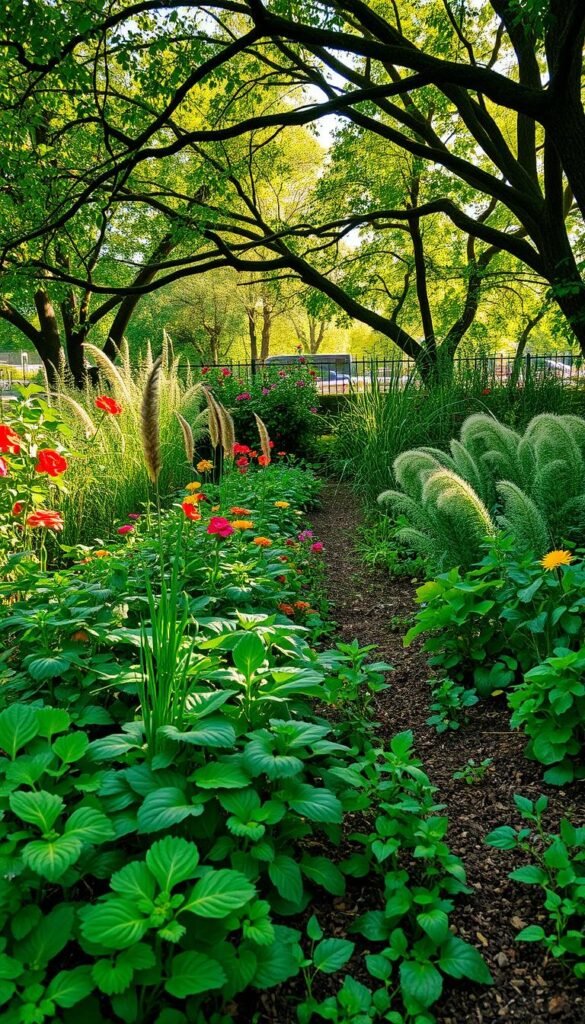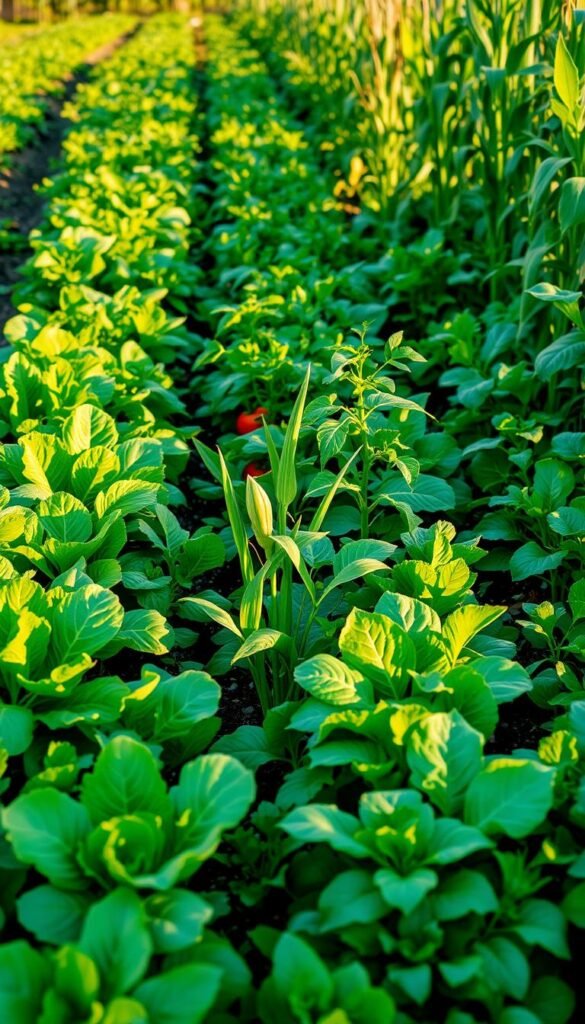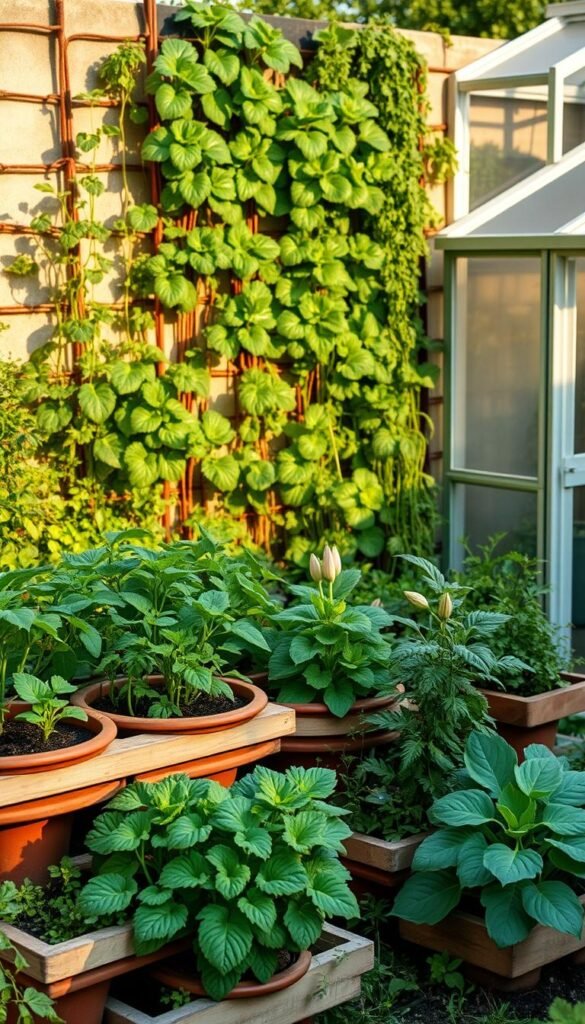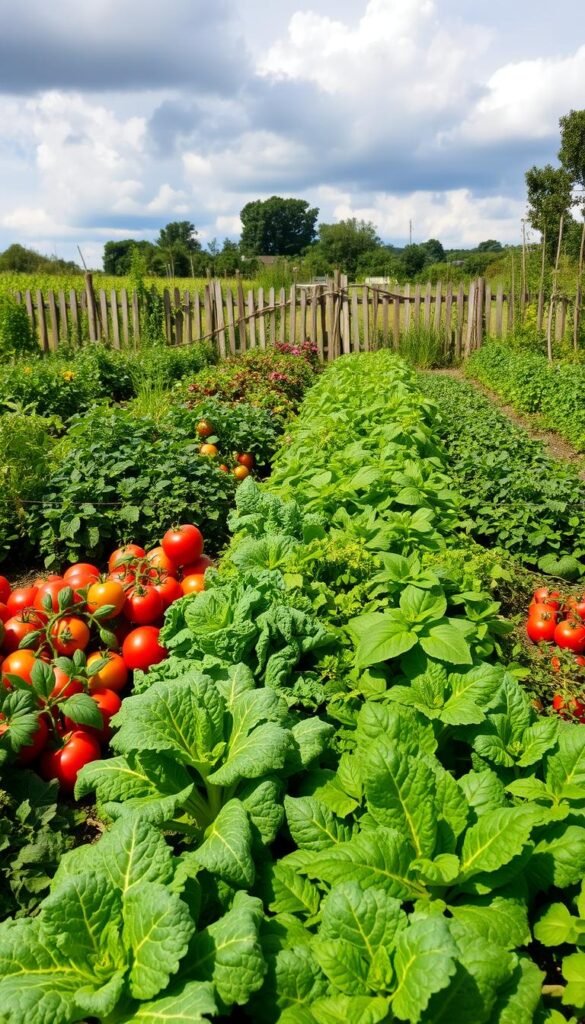What if your outdoor space could produce more food with less effort? For generations, growers have refined methods that work with nature rather than fighting it. These approaches aren’t just trendy—they’re proven solutions to modern challenges like limited space and soil health.
Traditional single-crop setups often drain nutrients and attract pests. But when you mix compatible plants or stagger growth cycles, magic happens. Your soil stays lively, yields increase, and pests struggle to gain footing. Best part? These systems require fewer chemicals because plants naturally support each other.
Whether you’re nurturing a backyard plot or container crops on a balcony, these principles adapt to your needs. They help create resilient ecosystems where every square foot counts. You’ll extend harvest seasons, reduce waste, and enjoy fresher meals straight from your soil.
The secret lies in mimicking nature’s patterns. Diverse plant groupings create microclimates that conserve moisture and nutrients. Timing your sowings ensures continuous harvests without overwhelming your space. Together, these methods form a self-renewing cycle that feeds both your family and the land.
Ready to transform how you cultivate food? Let’s explore how blending ancient wisdom with modern understanding can unlock your green space’s full potential.
Understanding the Foundations of Garden Vegetable Patch Strategies: Intercropping, Succession Planting, and More

Healthy soil and thriving greenery begin with diversity. When you mix various species, they create natural partnerships that strengthen your plot’s resilience. This approach mirrors wild ecosystems where plants collaborate to share resources and fend off threats.
The Power of Plant Partnerships
Different root depths and nutrient needs mean neighboring species rarely compete. Deep-rooted varieties draw minerals from subsoil, while shallow roots prevent topsoil erosion. This underground teamwork keeps earth fertile without synthetic additives.
Insect allies flock to varied plantings. Ladybugs patrol leafy greens, while ground beetles patrol soil surfaces. These natural defenders reduce pest populations by up to 60% compared to single-crop areas, according to recent agroecology studies.
Earth-Friendly Techniques That Last
Sustainable methods like rotating crops break pest cycles while replenishing nutrients. You’ll notice richer soil texture within seasons as organic matter increases. Healthier earth means stronger yields—no chemicals required.
“Diverse plots recover faster from extreme weather and resist disease outbreaks better than any monoculture.”
By working with nature’s rhythms, you create a self-regulating system. Less maintenance means more time enjoying crisp beans or sun-warmed tomatoes. Your green space becomes a living classroom where every plant teaches valuable lessons.
Why Traditional Farming Methods Fall Short for Modern Gardeners

Many growers stick to familiar routines, but yesterday’s practices struggle with today’s challenges. Single-crop systems might’ve fed families decades ago, but they now strain resources while offering diminishing returns. Let’s dig into why these old-school approaches no longer dig deep enough.
Limitations of Monoculture and Conventional Approaches
Planting the same crop year after year drains the earth’s vitality. Like eating only bread every meal, soil becomes malnourished. This forces reliance on synthetic fertilizers—a temporary fix that worsens long-term health. You’re not just feeding plants; you’re battling an exhausted ecosystem.
Pests thrive in predictable environments. Without diverse plant allies, harmful insects multiply unchecked. Research shows pest populations spike by 40% in monoculture plots compared to mixed plantings. More chemicals mean higher costs and contaminated runoff.
The Need for Innovative, Eco-friendly Solutions
Forward-thinking methods rebuild soil naturally while boosting food production. By mimicking wild ecosystems, you create habitats where beneficial insects patrol and nutrients recycle endlessly. Healthier land means tastier harvests—no lab-made additives required.
One study found gardens using these approaches reduced water use by 30% while doubling yields over three years. As climate shifts intensify, working with nature’s rhythms becomes essential—not optional—for reliable crops.
“Regenerative practices turn your plot into a living bank account—deposit organic matter now, withdraw abundant harvests later.”
These systems save money long-term. Less spending on fertilizers means more budget for heirloom seeds or rain barrels. Your space becomes a resilient food source, adapting gracefully to whatever the future holds.
Maximizing Your Garden Space Through Intercropping Techniques
Transform your planting area into a thriving ecosystem with clever plant partnerships. This method lets you grow multiple crops simultaneously while boosting soil health and deterring pests naturally. The trick lies in matching species with complementary needs and growth patterns.
Key Principles and Companion Planting Ideas
Start by pairing plants with different root depths and sun requirements. Tall crops like corn create shade for lettuce, while shallow-rooted herbs protect nutrient-hungry tomatoes. Timing matters—fast growers like radishes mature before slower neighbors need the room.
The classic “Three Sisters” trio demonstrates perfect synergy. Corn stalks support bean vines, beans add nitrogen to the soil, and squash leaves suppress weeds. This ancient strategy still outperforms modern monoculture in yield and sustainability.
Examples of Successful Crop Pairings
Try onions with carrots—their scents repel each other’s pests. Bush beans thrive beside celery, sharing space without competing for light. For vertical efficiency, grow cucumbers up trellises with spinach underneath.
“Smart pairings can increase yields by 20-30% compared to single-crop rows, according to urban farming trials.”
Radishes serve dual roles when planted with carrots. They mark rows early and break up soil as they’re harvested, giving carrots room to expand. Similar success comes from mixing leafy greens with broccoli—the greens mature quickly, while brassicas take center stage later.
Harnessing the Power of Succession Planting for Continuous Harvests

Keep your harvests rolling like a well-timed symphony. This method lets you grow fresh food non-stop by strategically timing your sowings. Instead of emptying beds after one crop, you’ll fill gaps with new plants ready to thrive.
Staggered Planting to Extend Your Growing Season
Plant fast-growing varieties every 7-10 days for steady yields. Radishes and leafy greens work perfectly—they sprout quickly and make room for slower crops. Your salads stay stocked without overwhelming your kitchen counter.
| Crop | First Planting | Interval | Harvest Period |
|---|---|---|---|
| Radishes | Early Spring | 10 days | 3-4 weeks |
| Lettuce | Late Spring | 7 days | 6-8 weeks |
| Bush Beans | Summer | 14 days | 4-6 weeks |
Timing and Crop Rotation Strategies
Track maturity dates like a pro. Cool-weather peas can yield space for heat-loving peppers by early summer. In fall, replace spent tomatoes with kale that thrives in crisp air.
“Gardeners using succession methods harvest 2-3 times more food from the same soil area annually.”
Rotate plant families yearly to prevent nutrient drain. Follow heavy feeders like corn with soil-builders like clover. Your earth stays balanced while your table stays full.
Boosting Soil Health and Nutrient Management in Your Vegetable Patch

Healthy earth forms the foundation of every thriving plot. Unlike synthetic fertilizers that offer quick fixes, natural methods build lasting fertility through biological teamwork. Let’s explore how your dirt becomes richer each season when treated like a living community.
Natural Methods for Improving Soil Fertility
Legumes like snap peas work underground miracles. Their roots host bacteria that convert air nitrogen into plant food—a process yielding up to 25 pounds of nitrogen per acre annually. Plant them beside corn or leafy greens to share this bounty freely.
Deep-rooted varieties act as nutrient elevators. Comfrey pulls potassium from 10-foot depths, while daikon radishes break up compacted earth. These “miners” leave trace minerals near the surface where shallow roots can access them.
| Plant Type | Key Benefit | Best Paired With |
|---|---|---|
| Clover | Nitrogen fixation | Brassicas |
| Sunflowers | Phosphorus cycling | Cucumbers |
| Buckwheat | Organic matter boost | Tomatoes |
Boost organic matter with kitchen scraps and fallen leaves. A 2-inch compost layer every spring feeds earthworms and microbes. These decomposers create crumbly humus that holds moisture like a sponge.
“Feed the soil, not just the plants—it’s the difference between renting and owning your land’s fertility.”
Try simple tests to monitor progress. Squeeze damp earth—good structure holds its shape briefly before crumbling. Yellow leaves often signal nitrogen needs, while purple tints hint at phosphorus shortages. Address these naturally with bone meal or fish emulsion.
Innovative Space-Saving Methods for Small Garden Areas

What if every inch of your growing area worked harder? Compact spaces demand smart solutions that layer productivity vertically and horizontally. These approaches let you grow more without expanding your footprint—perfect for urban balconies or petite backyards.
Vertical Cropping and Raised Garden Beds
Train vining crops to climb rather than sprawl. Pole beans ascend trellises while cucumbers cascade down A-frames. This approach yields 3x more food per square foot compared to ground planting, according to efficient space utilization studies.
Raised beds solve multiple challenges. They improve drainage, extend growing seasons, and let you customize soil blends. Try stacking planters for strawberries or herbs—each tier becomes its own microclimate.
| Crop | Support Type | Space Saved | Yield Increase |
|---|---|---|---|
| Tomatoes | Cage | 50% | 40% |
| Cucumbers | Trellis | 65% | 55% |
| Pole Beans | Netting | 70% | 60% |
| Zucchini | Stake | 45% | 30% |
Intensive Techniques Like Square Foot Gardening
Divide your plot into 12″x12″ grids. Each square hosts one crop type at optimized density—16 radishes or 1 broccoli per section. No wasted space means higher yields with less weeding.
Mix quick growers like spinach with slower plants. Harvest early crops before neighbors need room. This method can produce 100% more vegetables than traditional rows in the same area.
“Vertical systems transformed my 8×10 plot into a three-story food factory—I now harvest melons from eye level!”
Calculate spacing using seed packet directions, but plant in grids rather than rows. Tall plants go on north sides to avoid shading shorter companions. Your small space becomes a lush, edible mosaic.
Planning for a Year-Round Bounty with Seasonal Strategies
Imagine harvesting crisp greens through snowflakes and pulling root veggies as winter winds blow. By aligning your efforts with nature’s calendar, you unlock fresh flavors in every season. The key lies in strategic timing and cold-resistant varieties that laugh at frost.
Early Starts and Late Finishes
Kick off your year with frost-tolerant champions. Spinach and peas thrive when planted 4-6 weeks before your last spring frost. These pioneers establish roots in cool soil, exploding with growth as days lengthen.
Late summer becomes your second spring. Sow carrots and beets in August for sweet autumn harvests—cold temperatures boost their sugar content. Hardy kale planted in September often survives winter snows, offering fresh-picked nutrition during the leanest months.
“Season extension tools like $15 hoop houses can maintain harvestable conditions 8 weeks longer in northern zones.”
Try these winning combinations:
- Early spring: Radishes → Summer: Bush beans → Fall: Swiss chard
- Late winter: Garlic → Spring: Lettuce → Summer: Peppers
Regional adaptation makes all the difference. Southern growers can plant cool-weather crops like broccoli through mild winters. Northerners focus on quick-maturing fall varieties before heavy freezes. Either way, you’ll enjoy homegrown meals 10 months a year.
Expert Tips for Avoiding Common Pitfalls in Intensive Gardening
Your green space thrives when you sidestep common mistakes that trip up even seasoned growers. Smart prevention beats frantic cures every time—especially when nurturing delicate seedlings or maintaining essential tools.
Stopping Seedling Struggles Before They Start
Damping off crushes young plants in cold, soggy conditions. Use sterilized containers and let soil dry slightly between waterings. A fan circulating air prevents fungal growth better than any spray. For seeds, choose treated varieties that resist early disease threats.
Tool Care That Pays Dividends
Rusty tools spread plant illnesses faster than aphids. Scrub metal surfaces with a wire brush, then dip them in a sand-motor oil mix stored in a bucket. This gritty bath cleans blades while leaving protective coating. Test old seeds by sprouting them on damp paper towels—discard any batch under 70% viability.
Rotate crops yearly to confuse insects eyeing your tomatoes or onions. Healthy practices build success naturally, letting you focus on harvesting potential rather than fighting preventable problems. Your efforts now determine next year’s bounty.






